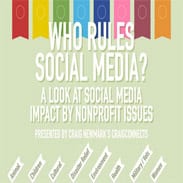Who Rules Social Media [Infographic]: A Look at Social Media Impact by Nonprofit Issues
The craigconnects team researched how the top 50 nonprofits do social media. Then they decided to dig a little deeper to find how nonprofits by area of focus use social media and what kind of an impact that they were having in the social media space. Here’s the Infographic they came up with.






















